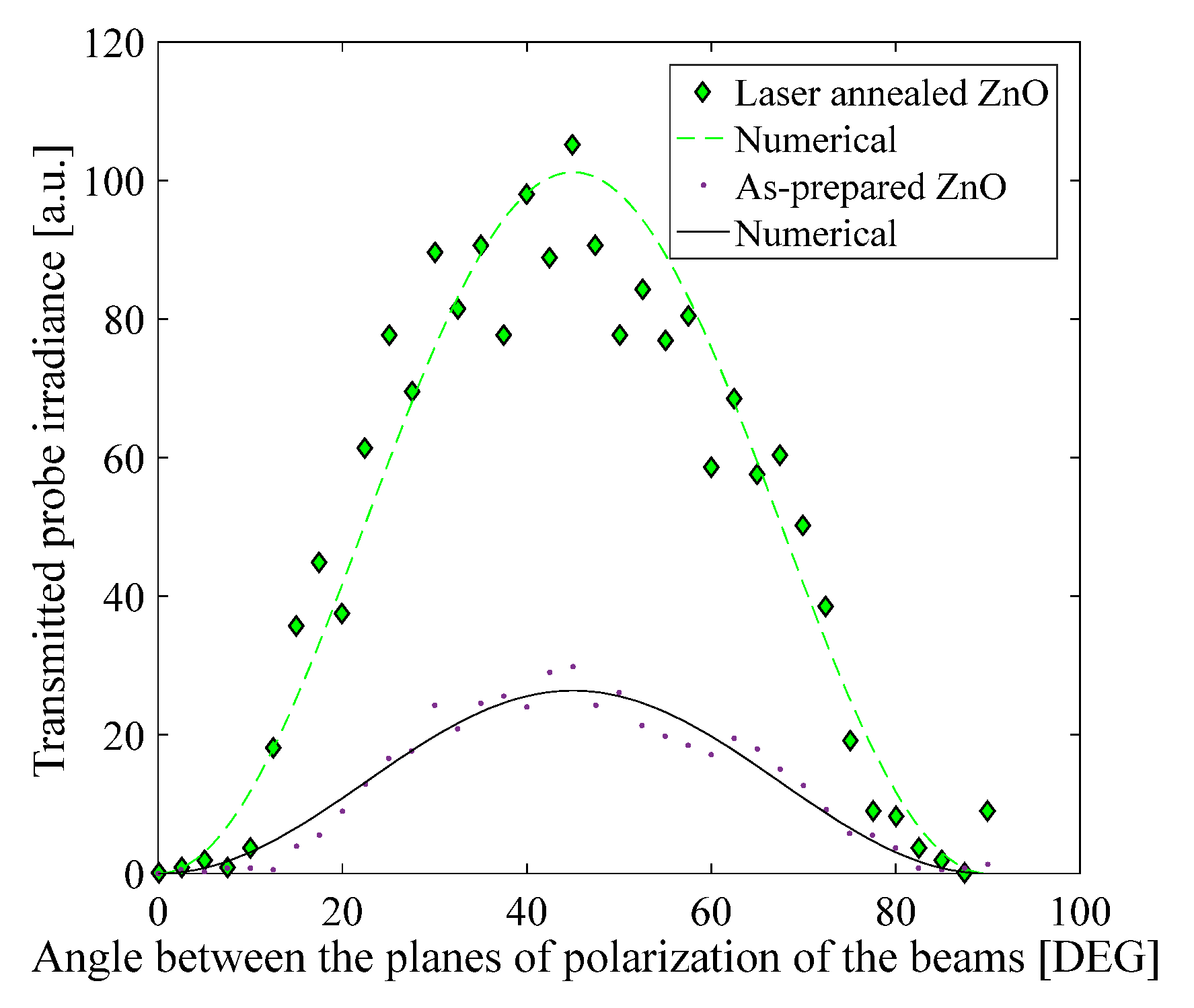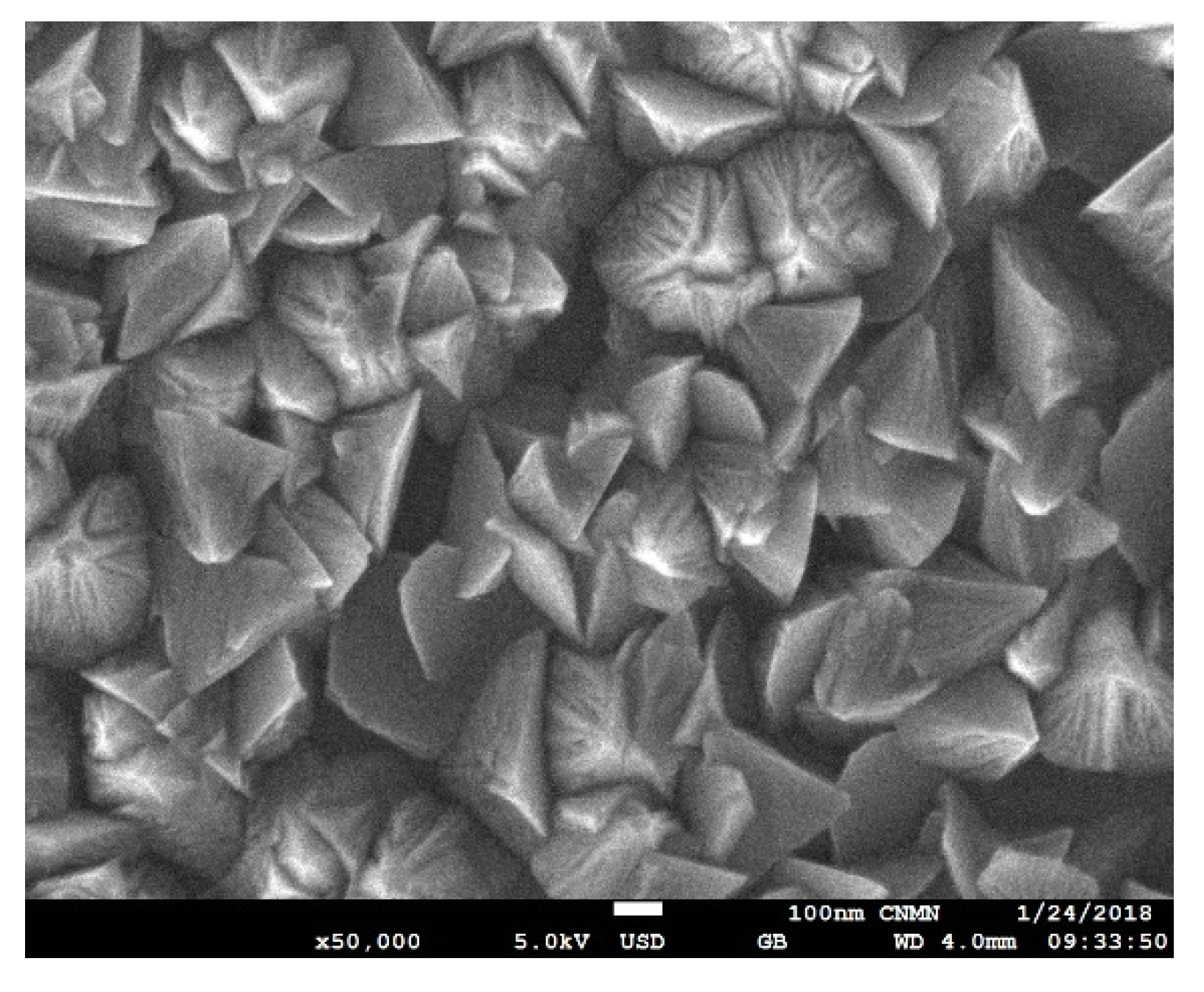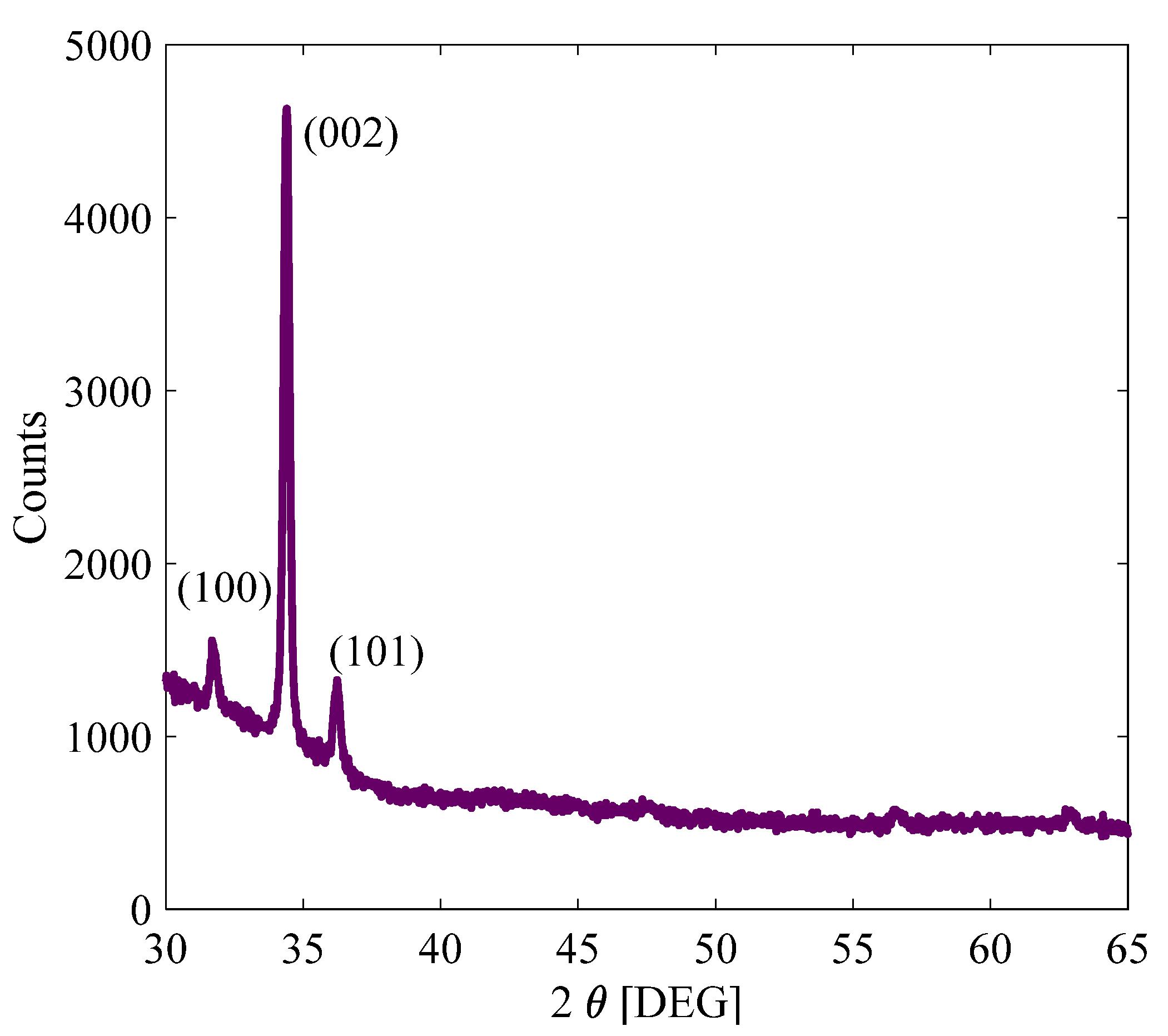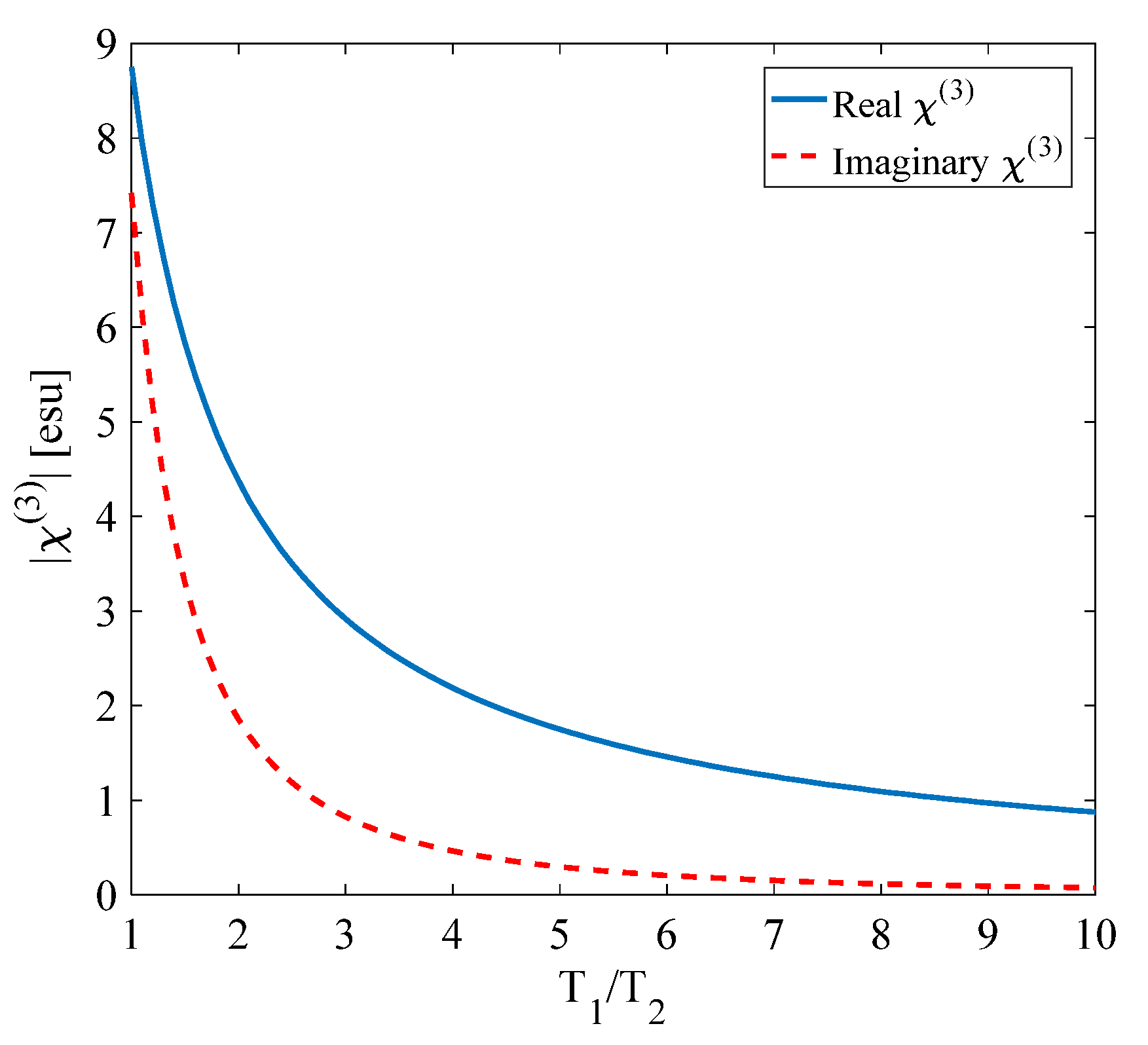Multipath Data Storage by Third-Order Nonlinear Optical Properties in Zinc Oxide Nanostructures
Abstract
1. Introduction
2. Materials and Methods
2.1. Sample Synthesis
2.2. Nanosecond Third-Order Nonlinear Optical Studies
3. Results
3.1. Nanosecond Third-Order Nonlinear Optical Studies
3.2. Non-Degenerated Two-Wave Mixing at 532 nm by Nanosecond Pulses
3.3. Morphology and Spectroscopy of the Samples
3.4. Multipath Load Balancing Assisted by Nonlinear Optical Properties
4. Conclusions
Author Contributions
Funding
Acknowledgments
Conflicts of Interest
Data Availability
References
- Kim, H.; Jung, K.; Yeo, S.J.; Chang, W.; Kim, J.J.; Lee, K.; Kim, Y.D.; Han, I.K.; Kwon, S.J. Long-distance transmission of broadband near-infrared light guided by a semi-disordered 2D array of metal nanoparticles. Nanoscale 2018, 10, 21275–21283. [Google Scholar] [CrossRef] [PubMed]
- Cesca, T.; Calvelli, P.; Battaglin, G.; Mazzoldi, P.; Mattei, G. Local-field enhancement effect on the nonlinear optical response of gold-silver nanoplanets. Opt. Express 2012, 20, 4537–4547. [Google Scholar] [CrossRef]
- Stepanov, A.L. Non-linear optical properties of metal nanoparticles implanted in silicate glass. Nucl. Instrum. Methods Phys. Res. Sect. B 2003, 206, 624–628. [Google Scholar] [CrossRef]
- Chen, Y.; Lai, Z.; Zhang, X.; Fan, Z.; He, Q.; Tan, C.; Zhang, H. Phase engineering of nanomaterials. Nat. Rev. Chem. 2020. [Google Scholar] [CrossRef]
- Kumar, S.S.; Venkateswarlu, P.; Rao, V.R.; Rao, G.N. Synthesis, characterization and optical properties of zinc oxide nanoparticles. Int. Nano Lett. 2013, 3, 1–6. [Google Scholar] [CrossRef]
- Chen, J.; Qiu, Y.; Yang, D.; She, J.; Wang, Z. Improved piezoelectric performance of two-dimensional ZnO nanodisks-based flexible nanogengerators via ZnO/Spiro-MeOTAD PN junction. J. Mater. Sci. Mater. Electron. 2020, 31, 5584–5590. [Google Scholar] [CrossRef]
- Fanizzi, F.P.; Jiang, J.; Pi, J.; Cai, J. The Advancing of Zinc Oxide Nanoparticles for Biomedical Applications. Bioinorg. Chem. Appl. 2018, 2018, 1062562. [Google Scholar] [CrossRef]
- Kaushik, V.; Rajput, S.; Kumar, M. Broadband optical modulation in a zinc-oxide-based heterojunction via optical lifting. Opt. Lett. 2020, 45, 363–366. [Google Scholar] [CrossRef]
- Serrà, A.; Gómez, E.; Philippe, L. Bioinspired ZnO-Based Solar Photocatalysts for the Efficient Decontamination of Persistent Organic Pollutants and Hexavalent Chromium in Wastewater. Catalysts 2019, 9, 974. [Google Scholar] [CrossRef]
- Zhong, J.; Vogelsang, J.; Yi, J.; Wang, D.; Wittenbecher, L.; Mikaelsson, S.; Korte, A.; Chimeh, A.C.; Arnold, L.; Schaaf, P.; et al. Nonlinear plasmon-exciton coupling enhances sum-frequency generation from a hybrid metal/semiconductor nanostructure. Nat. Commun. 2020, 11, 1464. [Google Scholar] [CrossRef]
- Khokhra, R.; Bharti, B.; Lee, H.; Kumar, R. Visible and UV photo-detection in ZnO nanostructured thin films via simple tuning of solution method. Sci. Rep. 2017, 7, 15032. [Google Scholar] [CrossRef] [PubMed]
- Kelly, K.L.; Coronado, E.; Zhao, L.L.; Schatz, G.C. The optical properties of metal nanoparticles: The influence of size, shape, and dielectric environment. J. Phys. Chem. B 2003, 107, 668–677. [Google Scholar] [CrossRef]
- Llopis-Lorente, A.; Díez, P.; Sánchez, A.M.; Marcos, D.; Sancenón, F.; Martínez-Ruiz, P.; Villalonga, R.; Martínez-Máñez, R. Interactive models of communication at the nanoscale using nanoparticles that talk to one another. Nat. Commun. 2017, 8, 15511. [Google Scholar] [CrossRef]
- Can-uc, B.; Rangel-rojo, R.; Rodríguez-Fernández, L.; Oliver, A. Polarization selectable nonlinearities in elongated silver nanoparticles embedded in silica. Opt. Mater. Express 2013, 3, 2012–2021. [Google Scholar] [CrossRef]
- di Ventra, M.; Stephane, E.; Heflin, J. Introduction to Nanoscale Science and Technology; Springer: Berlin/Heidelberg, Germany, 2004. [Google Scholar]
- Can-Uc, B.; López, J.; Lizarraga-Medina, E.G.; Borbon-Nuñez, H.A.; Rangel-Rojo, R.; Marquez, H.; Tiznado, H.; Jurado-González, J.A.; Hirata-Flores, G. Third-order nonlinear optical properties of a multi-layer Al2O3/ZnO for nonlinear optical waveguides. Opt. Express 2019, 27, 17359–17368. [Google Scholar] [CrossRef]
- Rasool, A.; Kumar, M.C.S.; Mamat, M.H.; Gopalakrishnan, C.; Amiruddin, R. Analysis on different detection mechanisms involved in ZnO-based photodetector and photodiodes. J. Mater. Sci. Mater. Electron. 2020, 31, 7100–7113. [Google Scholar] [CrossRef]
- Wang, K.; Zhou, J.; Yuan, L.; Tao, Y.; Chen, J.; Lu, P.; Wang, Z.L. Anisotropic Third-Order Optical Nonlinearity of a single ZnO Micro/Nanowire. Nano Lett. 2012, 12, 833–838. [Google Scholar] [CrossRef]
- Gupta, J.; Bhargava, P.; Bahadur, D. Fluorescent ZnO for imaging and induction of DNA fragmentation and ROS-mediated apoptosis in cancer cells. J. Mater. Chem. B 2015, 3, 1968–1978. [Google Scholar] [CrossRef]
- Zhang, L.; Wang, Y.; Wu, H.; Hou, M.; Wang, J.; Zhang, L.; Liao, C.; Liu, S.; Wang, Y. A ZnO nanowire-based microfiber coupler for all-optical photodetection applications. Nanoscale 2019, 11, 8319–8326. [Google Scholar] [CrossRef]
- Castro-Chacón, J.H.; Torres-Torres, C.; Khomenko, A.V.; García-Zárate, M.A.; Trejo-Valdez, M.; Martínez-Gutiérrez, H.; Torres-Martínez, R. Encryption of nonlinear optical signals in ZnO:Al thin films by ultrashort laser pulses. J. Mod. Opt. 2017, 64, 601–608. [Google Scholar] [CrossRef]
- Yatsui, T.; Jeong, H.; Ohtsu, M. Controlling the energy transfer between near-field optically coupled ZnO quantum dots. Appl. Phys. B 2008, 93, 199–202. [Google Scholar] [CrossRef]
- Torres-Torres, C.; Castañeda, L.; Trejo-Valdez, M.; Maldonado, A.; Torres-Martínez, R. Participation of the Third Order Optical Nonlinearities in Nanostructured Silver Doped Zinc Oxide Thin Solid Films. J. Nanomater. 2012, 2012, 353061. [Google Scholar] [CrossRef]
- Boyd, R.W. Nonlinear Optics, 3rd ed.; Academic Press: San Diego, CA, USA, 2008. [Google Scholar]
- Sheik-Bahae, M.; Said, A.A.; Wei, T.; Hagan, D.J.; Stryland, E.W.V. Sensitive measurement of optical nonlinearities using a single beam. IEEE J. Quantum Electron. 1990, 26, 760–769. [Google Scholar] [CrossRef]
- Chen, L.; Cui, Y.; Xiong, Z.; Zhou, M.; Gao, Y. Chemical functionalization of the ZnO monolayer: Structural and electronic properties. RSC Adv. 2019, 9, 21831–21843. [Google Scholar] [CrossRef]
- Yannopapas, V. Enhancement of nonlinear susceptibilities near plasmonic metamaterials. Opt. Commun. 2010, 283, 1647–1649. [Google Scholar] [CrossRef]
- Trejo-Valdez, M.; Torres-Torres, C.; Castro-Chacón, J.H.; Graciano-Armenta, G.A.; García-Gil, C.I.; Khomenko, A.V. Modification of the picosecond optical absorptive nonlinearity by a nanosecond irradiation in a nanostructured ZnO thin film. Opt. Laser Technol. 2013, 49, 75–80. [Google Scholar] [CrossRef]
- Multian, V.V.; Riporto, J.; Urbain, M.; Mugnier, Y.; Djanta, G.; Beauquis, S.; Galez, C.; Gayvoronsky, Y.V.; le Dantec, R. Averaged third-order susceptibility of ZnO nanocrystals from Third Harmonic Generation and Third Harmonic Scattering. Opt. Mater. 2018, 84, 579–585. [Google Scholar] [CrossRef]
- Karvonen, L.; Säynätjoki, A.; Chen, Y.; Jussila, H.; Rönn, J.; Ruoho, M.; Alasaarela, T.; Kujala, S.; Norwood, R.A.; Peyghambarian, N.; et al. Enhancement of the third-order optical nonlinearity in ZnO/Al2O3 nanolaminates fabricated by atomic layer deposition. Appl. Phys. Lett. 2013, 103. [Google Scholar] [CrossRef]






| Sample | α0 [cm−1] | Bandgap [eV] | n0 | n2 [m2/W] | β [m/W] | [esu] |
|---|---|---|---|---|---|---|
| As-prepared nanostructures | 1.0541 × 104 | 3.1813 | 1.95 | 1.7 × 10−15 | 4.4 × 10−9 | 2.54 × 10−9 |
| Laser annealed nanostructures | 1.0735 × 104 | 3.2059 | 1.95 | 5.9 × 10−15 | 11.9 × 10−9 | 8.80 × 10−9 |
© 2020 by the authors. Licensee MDPI, Basel, Switzerland. This article is an open access article distributed under the terms and conditions of the Creative Commons Attribution (CC BY) license (http://creativecommons.org/licenses/by/4.0/).
Share and Cite
Ortíz-Trejo, F.; Trejo-Valdez, M.; Campos-López, J.P.; Castro-Chacón, J.H.; Torres-Torres, C. Multipath Data Storage by Third-Order Nonlinear Optical Properties in Zinc Oxide Nanostructures. Appl. Sci. 2020, 10, 5688. https://doi.org/10.3390/app10165688
Ortíz-Trejo F, Trejo-Valdez M, Campos-López JP, Castro-Chacón JH, Torres-Torres C. Multipath Data Storage by Third-Order Nonlinear Optical Properties in Zinc Oxide Nanostructures. Applied Sciences. 2020; 10(16):5688. https://doi.org/10.3390/app10165688
Chicago/Turabian StyleOrtíz-Trejo, Federico, Martín Trejo-Valdez, Juan Pablo Campos-López, Joel Humberto Castro-Chacón, and Carlos Torres-Torres. 2020. "Multipath Data Storage by Third-Order Nonlinear Optical Properties in Zinc Oxide Nanostructures" Applied Sciences 10, no. 16: 5688. https://doi.org/10.3390/app10165688
APA StyleOrtíz-Trejo, F., Trejo-Valdez, M., Campos-López, J. P., Castro-Chacón, J. H., & Torres-Torres, C. (2020). Multipath Data Storage by Third-Order Nonlinear Optical Properties in Zinc Oxide Nanostructures. Applied Sciences, 10(16), 5688. https://doi.org/10.3390/app10165688







